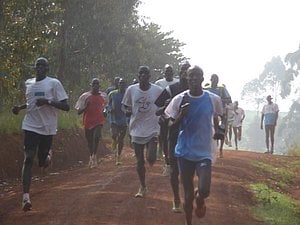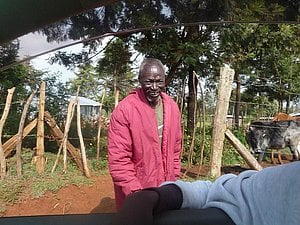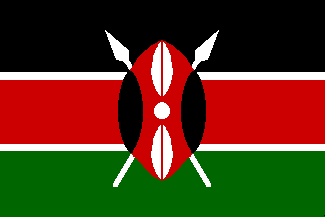
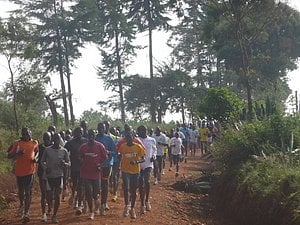 LetsRun.com Goes To Kenya - Post #4: Thursday Fartlek Run
LetsRun.com Goes To Kenya - Post #4: Thursday Fartlek Run
"If you want to choose the best, it is here now"
By Robert Johnson
July 20, 2011
Editor's Note: A few weeks ago, LetsRun.com co-founder Robert Johnson traveled to Kenya, spending two-plus weeks in the country. Over the span of a couple of weeks, he will be providing a series of posts about the trip to give you insight into the country that is home to many of the world's greatest distance runners. This is his fourth post. Soon, he'll also have safari and charity work photos where everyone will get to meet LetsRun.com's new unofficial mascot - LetsRun The Cow - a cow we donated to a women's micro-finance program.
Previous Coverage: LRC Post #3: A Workout With World Championship Silver Medallist Sylvia Kibet
LRC Post #2: Tuesday Track Workout In Iten + Sally Kipyego And Jake Robertson Unplugged
LRC Post #1: Sammy Wanjiru Was Not Murdered - LetsRun.com Explains How One Can Get Locked Into A Bedroom In Kenya
Photos/Video
LRC Photos From Kamariny Stadium in Iten, Kenya
from June 28, 2011 LRC Sylvia Kibet Photos
LRC *Video From Track *Robertson Interview *Sally Kipyego Interview
Coverage From Kenya From 2007: Kenyan Distance Running Part I: Kenya, The Land Of Opportunity
Post #4: Thursday Fartlek Run - "If you want to choose the best, it is here now."
Note: In addition to the print coverage, we also have a slew of videos at the end of this story plus a photo album: LRC Fartlek Photos + Photos of Lornah's Training Camp
Everyone in Iten, Kenya said there was one must see event - the Thursday fartlek. With (by some estimates) more than 1,000 runners training in Iten, 80% of whom apparently don't have coaches, most runners follow a plan of Monday steady, Tuesday track work, Thursday fartlek, and Saturday long run.
9-time NCAA champ Sally Kipyego had told me that she too was blown away by the amount of people that would do fartlek every Thursday and said I had to go see it. As I recapped in post #2, she told me, "When I got here, I went for a run at 10 o'clock and I think there were more than a thousand runners on the road. It just blew my mind. It's exciting (and it's) an eye opener - even for me being a Kenyan. I looked at the street and said, 'Look at these people.'"
Not being in any sort of running shape and not having a car in Kenya, I was wondering how I was possibly going to watch a fartlek run. Luckily for me, I bumped into Gilbert Koech coming out of the weight room at Lornah Kiplagat's High Altitude Training Center. Koech himself is a runner with PRs of 62:05 for the half and 2:14:39 for the marathon, but he's best known of late for being the husband and coach of 2010 ING New York City Marathon champ Edna Kiplagat.
Over the last 18 months, Kiplagat has been one of the revelations of the women's distance world. Heading into 2010, she was your average B-rate Kenyan with a 32-minute 10km best who made a very modest living on the roads, as she'd only run one marathon and it was a 2:50 back in 2005. Then in March of 2010, she ran 2:25:38 to win the LA Marathon and its battle of the sexes and more than $150,000 in cash and prizes. She followed that up with a win in New York and then followed that up with a 2:20:46 third-place finish at the Virgin London Marathon. That's a pretty darn good 13 months. From 2:50 to 2:20 in the marathon. Probably more than $500,000 in earnings. Very impressive.
As a coach myself, I was fascinated to ask Koech how Kiplagat had improved so much. What Koech said about his wife's improvement made a lot of sense and matches very well with my philosophy of coaching. Early in her career, Koech seemed to think Kiplagat didn't get put in big enough races. Kiplagat then was part of the Kimbia team coached by Dieter Hogan.
Koech said he thought the workout plan Hogan had for Kiplagat was simply too hard for his wife to do. Koech tried to get Hogan to back off on the workouts but Hogan believed in his plan. My take on it is that it seems that Kiplagat was simply too tired after the workouts in hindsight to do well in races. She'd left her race in practice.
It seems like a classic case of a coach trying to force a performance of a runner. On the collegiate level, you see it over and over again. A coach has success with a certain set of workouts and thinks, "If I can get my new runners to do these workouts, they will have similar success." But it often doesn't work out that way. In my mind, runners should hold back a little in most workouts and wait until early-season races to see where they really are instead of forcing out workouts - consciously or subconciously.
Forcing out workouts that All-Americans did was exactly what my brother, Weldon Johnson, was able to do in college and yet he was unable to break 30:00 for 10,000. After college, he likes to say his easy days got easier, his workouts got easier and he ran 28:06 (although it should be pointed out he did run more and lived at altitude - see more here: Wejo Speaks: Why I Sucked in College).
Now Kiplagat is under the guidance of her husband, who obviously knows her very well, and the ultra-successful Boulder Wave management team led by Brendan Reilly. Don't know the group? You should, as from 1996 to 2010, they have represented 10 of the 33 athletes who've won Olympic or World Championships marathon medals - that's a crazy, crazy stat.
But Kiplagat has always been a talent. She was a world junior silver medallist in 1996 and bronze medallist in 1998. With a maternity leave and a move up to the marathon, it just took a long time to come out.
Anyway, I bumped into Koech and Kiplagat and was very fortunate I did, as they became my unofficial hosts for the rest of the week. They were truly incredibly nice. I got to meet their great family, go out to eat with them, and - best of all from a LetsRun.com perspective - Koech offered to take me to the famed Thursday fartlek and let me see the madness myself, as he'd drive me in front of the runners with me hanging out the back of his SUV.
When I showed up Thursday morning, some of the runners Koech advises were preparing to jog to the starting line. Koech explained to them who I was and it was at this moment I had one of the highlights of the trip. Throughout my stay in Kenya, I'd told random people I bumped into in the non-running parts of Kenya (like Nairobi and in the safari parks) that I was into running and that I was in Kenya because they were home to many of the best runners. When I asked them if they knew much about running, they responded in many ways like an American would if you said to them, "Hey I know you guys have a ton of great swimmers. Tell me what you know about them." An American would probably say something like "Michael Phelps - Woo-Hoo!" The reaction in Kenya was similar - everyone knew a tiny bit - like everyone knew of Sammy Wanjiru's death, but few seemed to know much about running.
|
|
Well, Koech claimed nearly all of the elites he worked with knew about LetsRun.com, and so prior to the guys warming up, I asked for a show of hands. The response was nearly universal. Nearly all of them claimed to have had visited LetsRun.com. So we are famous in Kenya - at least in the elite world (either that or the guys did a great job of placating me by raising their hands).
Luckily, I video taped this part of the day (see it at the very start of the video on the left), but I pushed the wrong button a few minutes later when Koech introduced me to everyone running the workout and praised LRC - certainly a missed marketing moment. I did also interview two runners and asked them their PRs just prior to the start of the workout just to give you an idea of the type of talent that assembled before me (video appears at the bottom of this article).
Then we went from Koech's meeting point to the actual starting place of the fartlek. There were probably a couple hundred runners assembled. A very impressive number, although it was nowhere near the 800 or 1,000 figure I'd heard about, but people said it that it was sort of a down time of year as most of the road runners were either off racing or not gearing up yet for the fall. As for the male-female ratio, it was totally male-dominated. I'd say both at the fartlek and at the track on Tuesday, the ratio might have been higher than 20 to 1. Women runners in the US have it easier than their male counterparts, as there aren't nearly as many women competing in Kenya (or in much of the rest of the world, as well).
Koech got in front of them and then announced the workout: 16 x 2 minutes on/1 minute off - 50 minutes of fartlek basically. And then they were off. The workout was certainly fun to watch. The pack of several hundred gradually whittled down over time. A ton of the runners actually called it a day before the workouts was even halfway done - proving a point that I'll cover in a later post about how many of the guys trying to make it have no real shot of making it as a pro.
In the end, there were about 14 guys in the lead pack. Included in that pack was Wilson Kipsang, the 6th-fastest half marathoner in history at 58:59, which he ran in 2009 at the Ras Al Khaimah, and the 11th-fastest marathoner in history. Kipsang, who had run 60:49 to win in the Netherlands some 12 days before, certainly didn't stand out in the fartlek, as he was content to run in the back of the pack in like 12th for most of it. A guy who Koech didn't recognize shined for much of the latter stages of the workout. I respectfully refer to him as "MR. Mizuno Tights" guy. If anyone knows who he is by name, please email us.
As for the workout, there was a humorous moment on the last rep when a sheep decided to try to run next to the runners for a while before bolting in front of them. You can see it below at the 9:39 mark of the main video, which is top left, 28-second mark of the finish-only video (higher quality, no music - upper right).
For me, there were two highlights of the workout. In terms of running, the highlight came at the very end just after the top group of 14 guys had finished the workout. A Kenyan coach had accompanied me in Koech's car and he looked at the top group and simply (and perfectly) said to me, "If you want to choose the best, it is here now."
That's certainly true, as a couple hundred were whittled down to 14 over the span of less than 50 minutes.
The second highlight came in the middle of the workout when Koech slowed our car down and pulled over and waved at an elderly looking gentleman who was hobbling along down the dirt road, with either a cane or walking stick. Koech told me his name was Katui Cheruiyot and that he was the "founder of the marathon" in Kenya, as he'd run 2:12 back in the day when Kenyans were known for being good at everything but the marathon (I can't find any record of a Katui Cheruiyot, so if anyone knows his story, please email me). Pretty amazing that he might have helped kick-start the Kenyan dynasty, as the man certainly appeared to be anything but wealthy.
Koech reflected on how things have changed drastically in terms of training and - probably not coincidentally - success in the marathon in a very short period of time in Kenya (20 years ago, only one Kenyan had won the Boston marathon). The 30-year-old Koech says he remembers when early in his career he was told he nedeed to run a half marathon and he was "so scared." Now, there are hundreds of Kenyans training for a life of road racing in Iten alone.
The training now is also much more structured and focused than it was in the past.
"Now they train all the time. Ten years ago, it used to be everyone would take two months off (when the season was over)," said Koech.
So check out the videos and photos from the fartlek album below. Along the way, I did get some nice footage of Edna Kiplagat running as well, which appears below in the lower left quadrant. The pre-race interviews appear in the lower right quadrant. Note: The upper right video is just the finish of the upper left video but in higher definition and with no music in the background.
I hope you got a feel for what it was like in Iten, Kenya.
More: Videos Below + LRC Fartlek Photos + Photos of Lornah's Training Camp
|
|
|
|
|
|
Previous Coverage: LRC Post #3: A Workout With World Championship Silver Medallist Sylvia Kibet
LRC Post #2: Tuesday Track Workout In Iten + Sally Kipyego And Jake Robertson Unplugged
LRC Post #1: Sammy Wanjiru Was Not Murdered - LetsRun.com Explains How One Can Get Locked Into A Bedroom In Kenya
Photos/Video
LRC Photos From Kamariny Stadium in Iten, Keny
from June 28, 2011 LRC Sylvia Kibet Photos
LRC *Video From Track *Robertson Interview *Sally Kipyego Interview
Coverage From Kenya From 2007: Kenyan Distance Running Part I: Kenya, The Land Of Opportunity
Editor's Note: This piece was re-edited on 7/22/2011. If you have questions about what was removed, please email Robert.
|
|
|
|
|
|
Comments, questions, suggestions, story you'd like to submit? Email us.

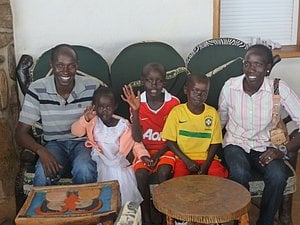
.JPG)
